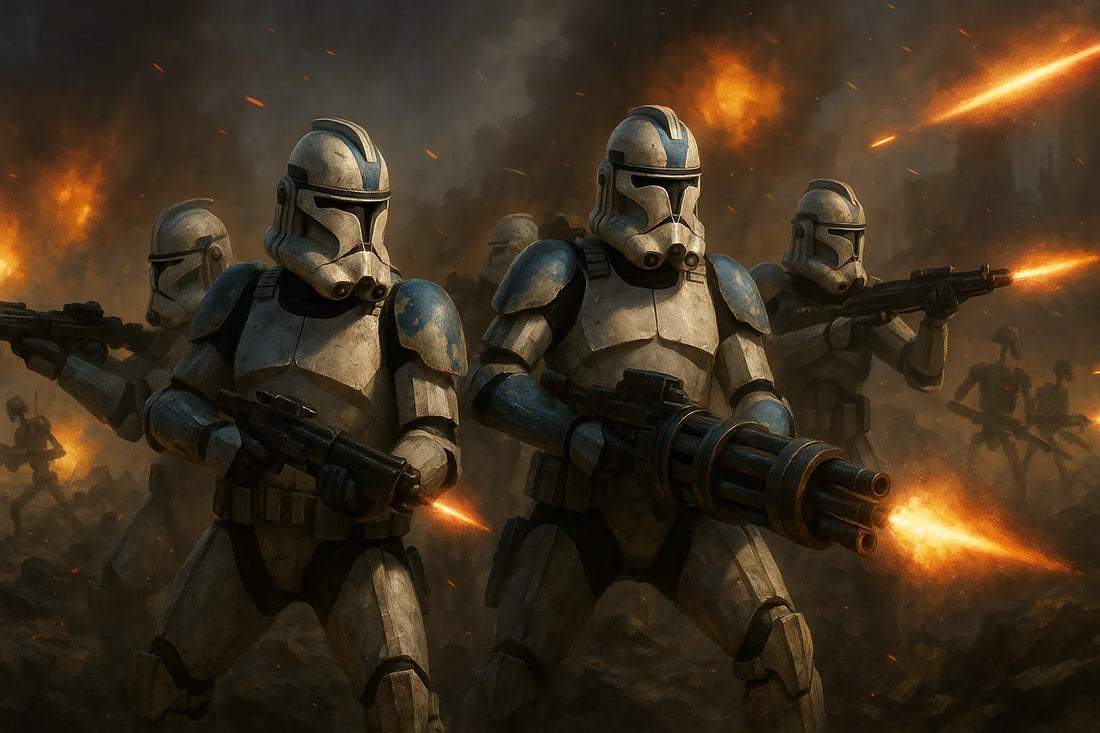Star Wars Clone Trooper Weapons: The Arsenal of the Galactic Republic
In the sprawling universe of Star Wars, Clone Troopers are among the most iconic military forces depicted in galactic history. Engineered on Kamino and commissioned by the Galactic Republic, these genetically enhanced soldiers were instrumental in the fight against the Separatists during the Clone Wars. Central to their effectiveness was their wide array of specialized weaponry, tailored for diverse combat scenarios. This article dives deep into the arsenal wielded by Clone Troopers, examining their standard and specialized gear, along with the cultural and historical impact these weapons have had within the franchise.
The Standard-Issue Blaster: DC-15 Series
The DC-15 series of blasters served as the backbone of the Grand Army of the Republic's firepower. These weapons were designed for durability, reliability, and performance under a variety of combat conditions—ideal for mass deployment to clone infantry forces.
DC-15A Blaster Rifle
The DC-15A blaster rifle was the primary long-range weapon used by clone troopers. Known for its considerable stopping power and extended range, it was ideal for mid-to-long distance combat. Despite its bulk and weight, the rifle offered formidable accuracy and was a key factor in the Republic's dominance on open battlefields.
DC-15S Blaster Carbine
The DC-15S was a more compact version of the DC-15A rifle, developed for close-quarters combat. Lightweight and easier to maneuver, this carbine was the preferred weapon of specialized units like clone paratroopers and urban assault teams. While it sacrificed some range and firepower, its improved handling made it ideal for quick, agile combat scenarios.
Advanced Weaponry for Specialized Units
DC-17 Hand Blaster
One of the most iconic sidearms in the Clone Wars, the DC-17 hand blaster was often seen in the hands of elite clone troopers like Captain Rex. Engineered for precision and quick draw capability, this blaster was ideal for close-quarters combat and fast-paced engagements. Dual-wielding DC-17s became a signature combat style for several high-ranking troopers.
Z-6 Rotary Blaster Cannon
When firepower was the priority, clone troopers deployed the Z-6 rotary blaster cannon. This heavy weapon featured a high rate of fire and was capable of sustained suppression against waves of droids. Despite its weight and size, the Z-6 was a favorite among heavy weapons specialists for its devastating output in dense battle scenarios.
Explosive Arsenal and Support Weapons
EMP Grenades and Thermal Detonators
Clone troopers often relied on EMP grenades to disable droids, temporarily short-circuiting their internal systems. Thermal detonators, on the other hand, were used for their high-yield explosive power and were ideal for destroying enemy cover, breaching strongholds, or eliminating tightly packed units. These tools added vital tactical flexibility to clone squads.
RPS-6 Rocket Launcher
The RPS-6 rocket launcher was designed to combat heavily armored targets such as tanks, walkers, and fortified installations. Though slower to reload and limited in ammunition, the RPS-6 packed a punch strong enough to alter the tide of battle. It was a crucial element in combined-arms strategies, especially when Republic forces faced overwhelming mechanized threats.
Experimental and Prototype Weapons
DC-17m Interchangeable Weapon System
Used exclusively by Republic Commandos, the DC-17m Interchangeable Weapon System was a modular masterpiece. It featured interchangeable attachments that transformed it into a standard blaster rifle, a sniper rifle, or an anti-armor grenade launcher. This versatility allowed commandos to adapt to a variety of combat situations without switching weapons entirely.
ARC Caster
The ARC Caster was a rare and highly advanced electromagnetic weapon capable of discharging bolts of electricity. Unlike traditional blasters, it could arc its shots between multiple targets, making it particularly effective against grouped enemies and droids. Though seldom seen on the battlefield, its destructive power made it a valuable asset in covert or experimental missions.

Vibroblades and Melee Combat Tools
Vibroknives and Combat Blades
While clone troopers primarily relied on ranged weapons, melee combat was sometimes unavoidable. For close-quarters encounters or stealth missions, many clones carried vibroknives—blades equipped with vibration generators to enhance cutting power. These weapons were especially common among ARC troopers and commandos, who often engaged in infiltration and sabotage missions.
Non-Lethal and Tactical Gear
Stun Batons and Riot Shields
Non-lethal equipment was rare but essential for specific missions, such as crowd control or hostage rescue. Stun batons delivered incapacitating electric shocks without lethal force, and riot shields provided physical protection during urban or defensive operations. While not widely used, these tools demonstrated the tactical breadth of clone warfare beyond traditional combat.
Weapon Customization and Unit Variants
Personalized Gear and Markings
Despite being genetically identical, many clone troopers took pride in personalizing their weapons and armor. This customization included unique paint jobs, tally marks, or modifications tailored to their combat preferences. These personal touches not only enhanced unit identity but also reflected the growing individuality of clones throughout the war.
Integration with Clone Armor
Clone weaponry was often integrated with their advanced armor systems. Helmets featured heads-up displays (HUDs) that linked with weapon scopes for improved targeting. Some weapons also interfaced directly with tactical visors or communication gear, creating a seamless combat ecosystem where real-time data improved accuracy and coordination.
Clone Troopers vs. Other Factions
Comparison with Droid Army Weaponry
The Separatist droid army relied on mass-produced, often poorly aimed blaster rifles. In contrast, clone weaponry was more advanced, offering superior range, accuracy, and durability. This technological edge, combined with the clones’ training, gave the Republic a distinct advantage in most engagements.
Comparison with Jedi and Sith Arsenal
While Jedi wielded lightsabers powered by the Force, clone troopers offered ranged firepower that complemented the Jedi's close-combat prowess. The synergy between lightsaber-wielding generals and blaster-equipped troopers created a tactical balance unmatched by other factions, allowing the Republic to execute coordinated and devastating battlefield strategies.
Iconic Weapons in Star Wars Media
Clone Wars Animated Series Highlights
The Star Wars: The Clone Wars animated series showcased a variety of clone trooper weapons in action. Episodes like the Battle of Umbara and the Siege of Mandalore highlighted the strategic application of blasters, explosives, and specialized gear in cinematic, story-driven conflicts that enriched the lore of the franchise.
Star Wars: Battlefront Game Series
In video games like Star Wars Battlefront II, players can step into the boots of clone troopers and wield their arsenal firsthand. These games faithfully reproduce blasters like the DC-15A and DC-17, offering both immersive gameplay and tactical options that mirror the complexity of clone weaponry seen in other media.
Legacy of Clone Trooper Weaponry
Influence on Imperial Stormtrooper Arms
Following the rise of the Galactic Empire, clone weaponry laid the foundation for future stormtrooper arms. While the Empire shifted toward mass production and cost-efficiency, many design elements—such as modularity and integrated tech—were retained and simplified. The transition from DC-15 models to the E-11 blaster rifle marks a significant evolution influenced by clone-era engineering.
Cultural Impact and Fan Replicas
Clone trooper weapons have become a beloved part of Star Wars fandom. Replicas of DC-series blasters and Z-6 rotary cannons are popular among collectors and cosplayers. Their distinctive look and tactical function have inspired countless fan-made designs and appearances at conventions, fan films, and themed events around the globe.
Conclusion
The weapons of the Clone Troopers are more than just tools of war—they represent innovation, adaptability, and the complex legacy of the Republic’s greatest soldiers. From the standard-issue DC-15A to the rare and powerful ARC Caster, each weapon played a critical role in defining both the battlefield and the enduring mythology of Star Wars. As fans continue to explore the Clone Wars through shows, games, and collectibles, the fascination with clone weaponry remains as strong as ever.
Frequently Asked Questions (FAQs)
1. What is the most powerful clone trooper weapon?
The Z-6 rotary blaster cannon is often considered the most powerful due to its high rate of fire and heavy suppression capability.
2. Why did clone troopers use different weapons?
Clone troopers used various weapons tailored to their roles—snipers, heavy gunners, commandos, and standard infantry all required specialized gear to operate effectively.
3. Are clone weapons better than stormtrooper weapons?
Clone weapons like the DC-15 series were more advanced and durable. Stormtrooper arms prioritized mass production over performance, resulting in a drop in quality.
4. Can you buy replica clone weapons?
Yes, numerous companies and fan creators offer detailed, non-functional replicas for cosplay and collection, often modeled after screen-accurate designs.
5. Did clone troopers ever use Jedi lightsabers?
While not standard practice, there are rare instances in expanded lore where clone troopers briefly used fallen Jedi lightsabers, typically in emergency situations.




